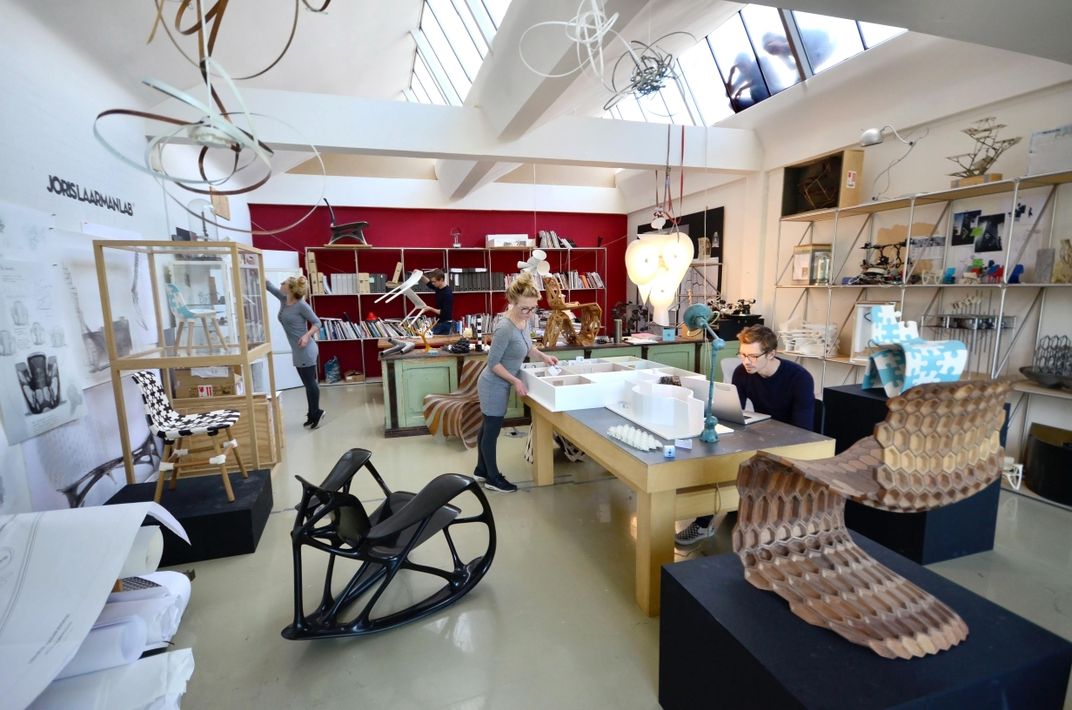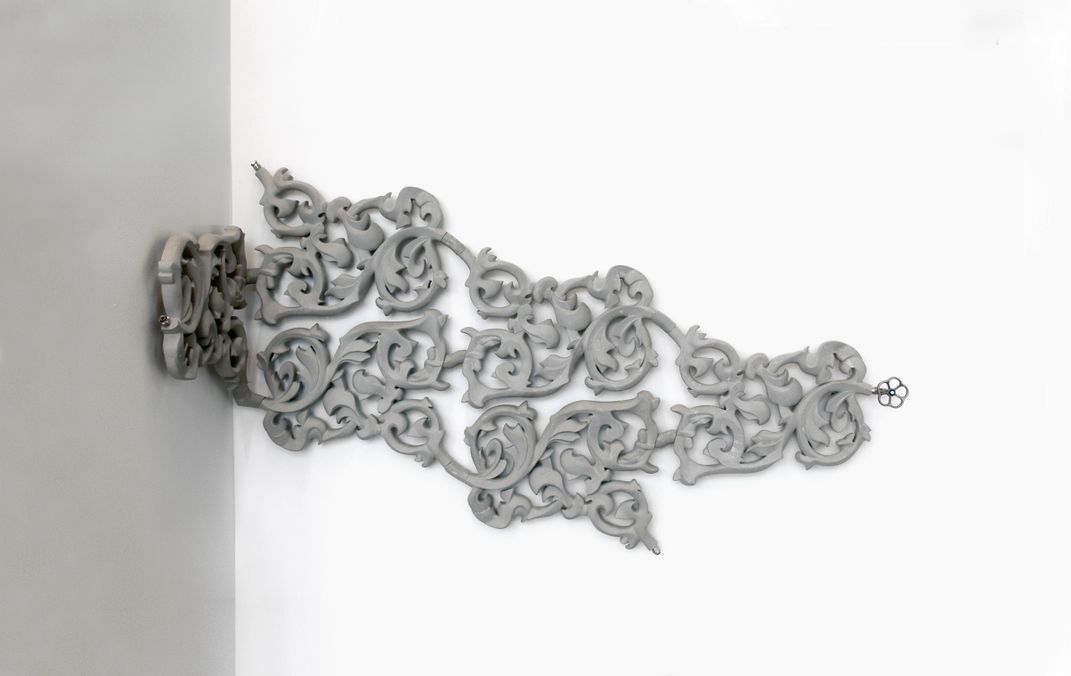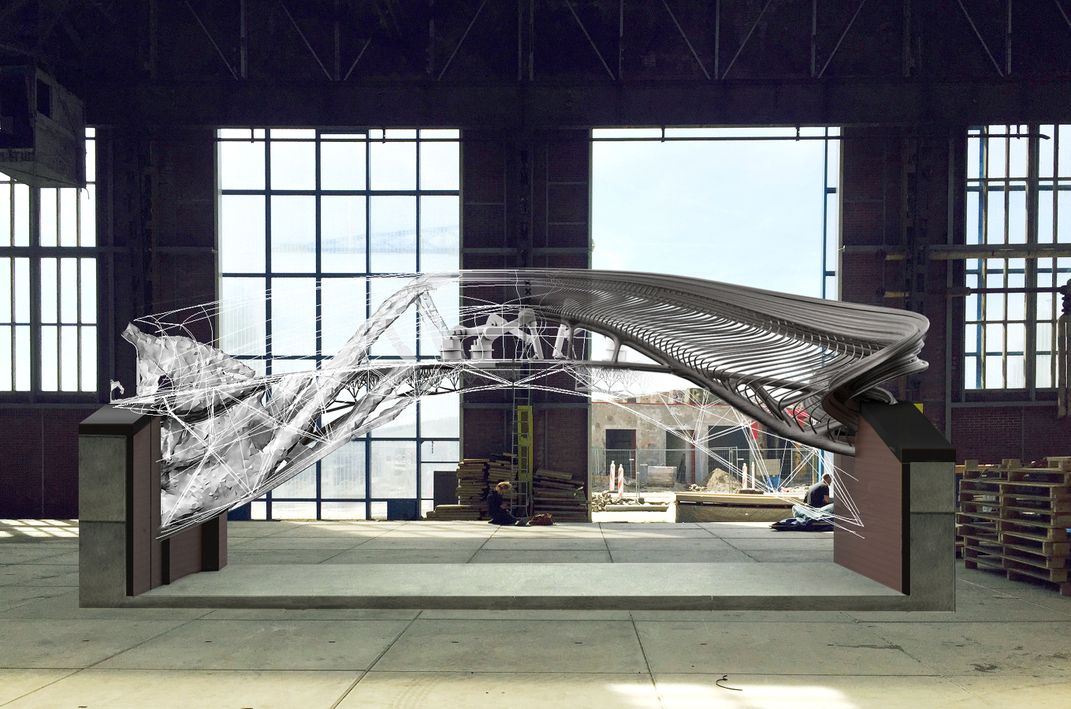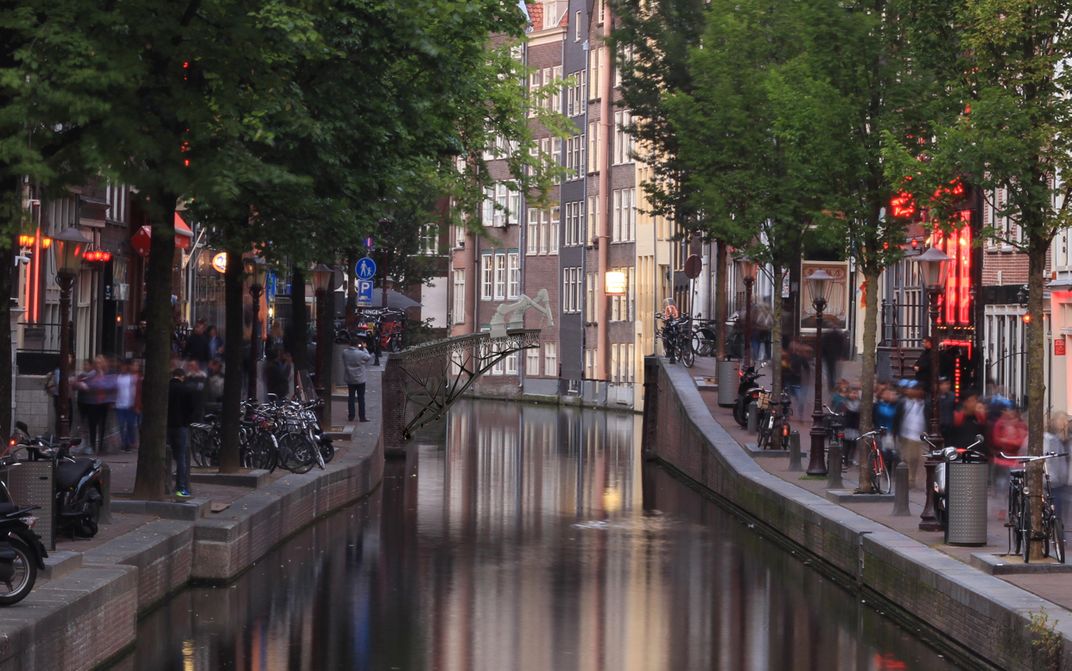Have We Been Building Chairs All Wrong?
Experimental Dutch designer Joris Laarman uses algorithms and digital technology to innovate through constraint
/https://tf-cmsv2-smithsonianmag-media.s3.amazonaws.com/filer/25/89/2589f82f-5562-40c6-a81e-6e6370a638e5/armchair.jpg)
Innovation is often thought of as a breaking of rules or norms, of transcending what was once thought possible, of “thinking outside the box.” But innovation can also grow from constraint, from limiting a creator’s options and forcing him or her to rethink and reinvent within those boundaries.
That’s the outlook embraced by Joris Laarman, a Dutch designer who has developed striking designs for chairs, tables and now a bridge, by relying on complex algorithms and cutting-edge technology. His lab’s work is being showcased in the new exhibition, “Joris Laarman Lab: Design in the Digital Age,” at the Cooper Hewitt, Smithsonian Design Museum in New York City. Running through January 15, 2018, the show explores the paradox of Laarman’s approach to creativity.
Exhibit A is Bone Chair, inspired by the work of the German professor Claus Mattheck, who studies the biomechanics of the natural world, such as the innate ability of bone to remove material that is not needed for strength (just as trees add material). Mattheck’s ideas of material optimization were developed into an algorithm and imaging software initially used by General Motors to create a more powerful engine mount. Laarman saw its potential in the area of furniture design.
By applying the same effort to optimize mass, chipping away material where it’s not needed, the “legs” of the chair became a multi-pronged, interconnected web. It looks very different than anything someone might just come up with on their own, serving as a feat of both human engineering and laws of nature.
“I would never design that myself, but with the help of the algorithm you get all these unexpected results,” says Laarman. “It’s a high-tech version of Art Nouveau.”

That paradox of ornamental and essential, high-tech engineering and old-fashioned craftsmanship, can be found in many of the pieces produced by the Joris Laarman Lab. Founded in 2004 by Laarman and filmmaker and partner Anita Star, the lab has brought together a team of engineers, craftsmen, and programmers dedicated to experimentations in this type of tech-infused craftsmanship.
“He’s doing design, but digging much further)—even though there are these realized objects, there are all these layers,” says Cooper Hewitt assistant curator of contemporary design Andrea Lipps, who is overseeing the show (it was originally organized by the Netherlands’ Groninger Museum).
Another example is Laarman’s Heat Wave Radiator, which the Cooper Hewitt acquired after featuring it in the museum’s 2008 exhibition “Rococo: The Continuing Curve.” Rather than the unsightly coiled pipes of a traditional radiator, Laarman’s lab created an elaborate floral design with the piping, producing a piece that serves as a stunning piece of wall art as much as a functional heater. But while such panache would seem far from efficient functionalism, the piece was designed with function as a top priority: to better disperse heat than a traditional radiator.

While the first Bone Chair was designed from aluminum, the program developed by the lab allows the user to enter different materials, weights, and other specifications, each time creating a singular design.
“It’s just one press of the button to make the chair into a loft seat or table,” says Laarman. “The system adapts to the requirements of your design. Every part of these chairs makes sense, but it’s a form you never expect.”
The use of set algorithms also means that the lab’s innovations can be replicated elsewhere. For example, Laarman made the digital blueprints for his Maker Chairs (a dozen of which are on display in the show), created from puzzle-like pieces of wood, 3D printed plastics, and more; and, available as open-source designs.
“You can replicate these chairs with small CNC machines or a 3D printer or laser color,” he says.
Laarman expects this approach to grow in popularity, particularly with block-chain technology, which allows for the sharing of creative work in a way that the creator maintains intellectual property rights and receives payments. In Laarman’s vision, the independent workshop has more power—being able to replicate designs or work off of them to create something of their own—and deliver them directly to buyers, without the need for a mass manufacturer in between. It flips the traditional industrialization approach of a creative design being purchased by a big brand, which then manufactures it cheaply and sells it only in its stores.
“Last century was all about industrialization and craft basically disappeared, it became more of a hobby,” says Laarman. “Digital fabrication allows local workshops to become functional and relevant again.”
Lipps agrees that the robots and algorithms that execute Laarman’s work are in many ways just tools to more effectively create old-fashioned crafts.
“There’s all this anxiety around automation, but even though they are digging into 3D printing and emerging digital fabrication processes, the hand and craftsmanship is so integral to creating all of these things,” says Lipps. “People are still such an important part of realizing all of this.”
Technology also facilitates sharing of ideas—which has been central to the lab’s innovation.
“You can see the rise of Google through the show, because the internet has provided this enormous world of information,” says Laarman. “I could just email scientists who were working on something interesting to help me with design.”
Take the Digital Matter table series, which used industrial robots and smart software to create three ornamental tables, incorporating characters and aesthetic elements from Nintendo’s “Super Mario” video games. They are based on research being explored by a number of universities including MIT, Carnegie Mellon, and Cornell, looking at self-assembling molecular building blocks—something like an organic version of Lego. Robots assemble and reassemble the building blocks, or voxels, based on a digital blueprint.
Each table in the series uses increasingly smaller blocks, smoothing out and becoming more high resolution, in this way representing what Laarman calls “frozen moments” in the ongoing development of what these increasingly advanced robots are able to create.
While Laarman and his team have gotten ever-more detailed and sophisticated with its creations, it has lately tackled a new challenge: size. To this end, the lab has developed MX3D, a first-of-its-kind printing process that uses robot arms and advanced welding machines to print in mid-air.
“So you’re not constrained to just printing what a box can print,” says Lipps. “It’s totally blowing up the traditional form.”
The new technology has allowed Laarman and his team to create perhaps their most ambitious project yet: The MX3D Bridge, a fully functional footbridge that is being 3D printed in stainless steel over a canal in Amsterdam. Using advanced robotic technology, the metal is 3D printed without the need of a support structure that such an engineering project would usually require. The bridge is expected to debut in 2018 (and a section is on display as part of the Cooper Hewitt show).
The algorithm analyzes the stresses that go through the bridge surface and the lab prints thicker beams for where stresses are highest and reduces material in places where it is lowest. It also has to adapt to the surroundings of a very old city, being both contemporary while sharing the city’s aesthetic.
“It has a sort of S-curve and is not symmetrical, so it’s kind of complex to design its construction because you never know where it could use extra material,” says Laarman.
So with all this artificial intelligence, where does the person fit into the creative process?
“I only use it as a tool—you have to provide the input and by controlling or changing the input, the algorithm creates a different design,” says Laarman. “The future is going to be scary but super exciting at the same time.”
"Joris Laarman Lab: Design in the Digital Age" is on view at the Cooper-Hewitt, Smithsonian Design Museum through January 15, 2018 in New York City.
Take the Digital Matter table series, which used industrial robots and smart software to create three ornamental tables, incorporating characters and aesthetic elements from Nintendo’s “Super Mario” video games. They are based on research being explored by a number of universities including MIT, Carnegie Mellon, and Cornell, looking at self-assembling molecular building blocks—something like an organic version of Lego. Robots assemble and reassemble the building blocks, or voxels, based on a digital blueprint.
Each table in the series uses increasingly smaller blocks, smoothing out and becoming more high resolution, in this way representing what Laarman calls “frozen moments” in the ongoing development of what these increasingly advanced robots are able to create.
While Laarman and his team have gotten ever-more detailed and sophisticated with its creations, it has lately tackled a new challenge: size. To this end, the lab has developed MX3D, a first-of-its-kind printing process that uses robot arms and advanced welding machines to print in mid-air.
“So you’re not constrained to just printing what a box can print,” says Lipps. “It’s totally blowing up the traditional form.”
The new technology has allowed Laarman and his team to create perhaps their most ambitious project yet: The MX3D Bridge, a fully functional footbridge that is being 3D printed in stainless steel over a canal in Amsterdam. Using advanced robotic technology, the metal is 3D printed without the need of a support structure that such an engineering project would usually require. The bridge is expected to debut in 2018 (and a section is on display as part of the Cooper Hewitt show).
The algorithm analyzes the stresses that go through the bridge surface and the lab prints thicker beams for where stresses are highest and reduces material in places where it is lowest. It also has to adapt to the surroundings of a very old city, being both contemporary while sharing the city’s aesthetic.
“It has a sort of S-curve and is not symmetrical, so it’s kind of complex to design its construction because you never know where it could use extra material,” says Laarman.
So with all this artificial intelligence, where does the person fit into the creative process?
“I only use it as a tool—you have to provide the input and by controlling or changing the input, the algorithm creates a different design,” says Laarman. “The future is going to be scary but super exciting at the same time.”
"Joris Laarman Lab: Design in the Digital Age" is on view at the Cooper-Hewitt, Smithsonian Design Museum through January 15, 2018 in New York City.
/https://tf-cmsv2-smithsonianmag-media.s3.amazonaws.com/accounts/headshot/Alex_Palmer_lowres.jpg)




/https://tf-cmsv2-smithsonianmag-media.s3.amazonaws.com/accounts/headshot/Alex_Palmer_lowres.jpg)